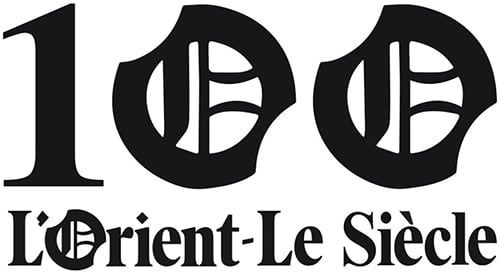During an event organised by Biladi, School children reproduce a scene sculpted on Ahiram sarcophagus, at the National museum of Beirut. Photo Biladi
May 2012, Smar Jbeil, Lebanon. At the heart of the crusaders' castle ruins at Chmor Kbal, some thirty children discovered, in awe, the vestiges of a dungeon, arrow slits and ramparts dating back 900 years. Led by a young passionate guide, these 12-13 year-old Lebanese students traveled back in time. Dressed up as kings, queens, knights and peasants, they brought the castle back to life by taking part in theatrical sketches.
Inspiring Lebanese youth to rekindle a relationship with their heritage is Joanne Farchakh Bajjaly's foremost ambition and the mission she's devoted herself to through Biladi, the NGO she founded in 2005. "By organizing educational and fun excursions to different sites all over Lebanon, we seek to bring life into learning history." Biladi's director is certain of it: heritage protection stems from education. "Laws aren't sufficient," she says, "particularly in times of war."
For this forty year-old Lebanese woman, the idea fell into place in two stages. It was triggered in 1993, in the aftermath of the Civil War, when, as an archeology student, she took part in Beirut's excavations. "We would work on the site for seven to eight months, and then a bulldozer would come and destroy everything, to 'rebuild the city'. I saw Roman columns crumble into a pile of pebbles."
She decided to find a way to save these treasures. This quest took her to Syria, a peaceful country at that time, and then later through Iraq at war. In Baghdad she met Brahim. In 2003, this Iraqi pianist, having found out that the museum of Baghdad was being attacked by looters, rushed over to save an Assyrian statue. After hiding it for two weeks in his own home, he returned it to the authorities. "He had saved it because, as a child, he had visited the museum and had fallen in love with the statue." This story gave life to Biladi.
Through her empirical research and on-site experiences in three different contexts (post-war Beirut, peaceful Syria and war-torn Iraq), Joanne Farchakh came up with heritage-focused educational programs.
Launching her project, the archeologist had expected logistical hurdles. Yet she decided that the only barriers are in one's head. "Children inherited our own deep-rooted fears in the aftermath of the Civil War (1975-1990). Muslims or Christians alike, a rejection of 'the other' has been taken up among children, without them even precisely knowing the reason why. Some refuse to visit 'the other's sites', cathedral or mosque alike. With our excursions, we try to fight against this isolation." Since 2005, more than 30 000 Lebanese youths have participated in Biladi's educational itineraries throughout Lebanon.
August 2015, Jounieh, north of Beirut. Cries of joy resonated though a church's courtyard. Enthused Syrian children moved a mini car across a giant map of Syria, from the banks of the Euphrates to Palmyra, via Aleppo. In an adjacent building, a group discovered how Hama's waterwheels work while young girls built Aleppo's citadel out of wooden blocks. "I remember having been there, before the war," shared Aisha, 13. Besides her, Mariam discovered this jewel of Syrian heritage. Aisha and Mariam were among a group of refugees partaking in 'Syria In My Mind', an educational project set up in 2013 by Baladi in partnership with the Italian foundation, Avsi, and financed by UNICEF. Once again, the goal is to recreate a positive connection between these children and their motherland, building associations other than those of war, tears and fear. Nearly 52% of more than a million Syrian refugees registered in Lebanon's UNHCR offices are under 18 years old. A "lost generation" according to UNICEF.
Syria has entered its sixth year of war. More than nine hundred monuments or archeological sites have been damaged or destroyed. When not turned to dust by bombings or bulldozers, they are looted. In Iraq, the situation is no less worrisome, with the destruction of Mesopotamia's heritage, site after site. "Never, since the major conquests such as those of Alexander the Great, has the regional heritage been as threatened as it is today," states Farchakh. "These civilizations may have destroyed, but they also rebuilt in their own image. Daesh (Arab acronym for the jihadist Islamic State) destroys, in a preconceived way, to leave nothing but nothingness. Their strategy is to wipe out entire populations, both their present and their past, in order to control their future. It's so important for young generations of refugees to get to know their heritage, otherwise they risk entering into a process of massive self-destruction once they return to their motherland."
More than 2500 Syrian child refugees in Lebanon have benefited from 'Syria In My Mind'. Today, Joanne Farchakh stresses the importance of broadening perspectives, and hopes that by the beginning of the next school year, the program will include not only Lebanese, but also Iraqi students. The objective is for each one to get to know about her or his own heritage and that of other countries in the region. "This way the children will be enriched collectively, and develop mutual respect of each other's heritage, and therefore of each other's identity," believes Biladi's president. "We want to go beyond the image of the young refugee deprived of everything. Every refugee is the bearer of a millenary heritage, an inestimable one. We want to give back to Iraqi and Syrian refugees their own dignity and identity."
(translated by Caterina Belardi)
Voir aussi



commentaires (3)
Bonjour, Cette année, L'Orient-Le Jour a publié deux versions de son édition de l'Impact Journalism Day. la première en français et la seconde en anglais. Bien à vous, L'Orient-Le Jour
L'Orient-Le Jour
14 h 39, le 04 juillet 2016